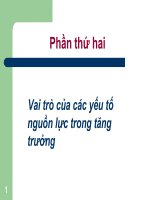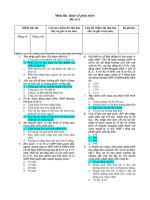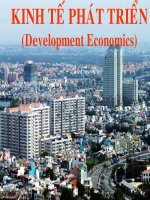Human Traficking Kinh Tế phát triển : BUÔN BÁN NGƯỜI
Bạn đang xem bản rút gọn của tài liệu. Xem và tải ngay bản đầy đủ của tài liệu tại đây (1.58 MB, 22 trang )
SUBJECT: HUMAN TRAFFICKING
Table of content
I. Statistic of human trafficking in each countries , areas
II. What is human trafficking ?
III. Who are the victims ? What is the target of each of the victims ?
IV. Why is the human trafficking happen ?
V. Preventation of human trafficking
• The solutions of governments, non-governmental organizations ?
• What can you do ?
I, What is human trafficking?
-
On the basis of the definition given in the Trafficking in Persons Protocol, it is evident
that trafficking in persons has three constituent elements;
The Act (What is done)
Recruitment, transportation, transfer, harbouring or receipt of persons
The Means (How it is done)
Threat or use of force, coercion, abduction, fraud, deception, abuse of power or
vulnerability, or giving payments or benefits to a person in control of the victim
The Purpose (Why it is done)
For the purpose of exploitation, which includes exploiting the prostitution of others,
sexual exploitation, forced labour, slavery or similar practices and the removal of organs.
To ascertain whether a particular circumstance constitutes trafficking in persons, consider
the definition of trafficking in the Trafficking in Persons Protocol and the constituent
elements of the offense, as defined by relevant domestic legislation.
Human Trafficking = Act + Means + Purpose
1: Act
-
Recruitment
-
Transportation
-
Transfer
-
Harbouring
-
Receipt of persons
2: Means
-
Threat or use of force
-
Coercion
-
Abduction
-
Fraud
-
Deception
-
Abuse of power or vulnerability
-
Giving payments or benefits
3: Purpose
-
Exploitation, including
-
Prostitution of others
-
Sexual exploitation
-
Forced labour
-
Slavery or similar practices
-
Removal of organs
-
Other types of exploitation
II, Victims
The International Labor Organization estimates that there are 40.3 million victims of human
trafficking globally, with hundreds of thousands in the United States. The victims of this crime
are men and women, adults and children, and foreign nationals and U.S. citizens. As defined by
U.S. law, victims of human trafficking can be divided into three populations:
•
Children under the age of 18 induced into commercial sex
•
Adults (age 18 or over) induced into commercial sex through force, fraud, or coercion
•
Children and adults induced to perform labor or services through force, fraud, or coercion
III, Statistic of human trafficking in each countries , areas
Human trafficking is a multi-billion dollar enterprise, and it’s one of the fastest-growing illicit
industries in the world .To many around the world, the term "slave" is a word of the past, as the
idea of selling and buying humans is rightfully a practice left behind in the malicious annals of
time. The reality of the situation is that human trafficking is still one of the most lucrative
criminal industries today, raking in an estimated 32 million dollars per year. It is not only
confined to developing countries - even within the United States, there are around 15,000 people
trafficked each year.
Each year, the U.N. marks World Day Against Trafficking in Persons, which falls on July 30 this
year, to help raise awareness. The U.S. State Department annually investigates more than 100
countries for its Trafficking in Persons report. In the 2017 report, 23 countries were classified as
Tier 3, the lowest classification for countries that “do not fully meet the Trafficking Victims
Protection Act’s minimum standards and are not making significant efforts to do so.”
North Africa
Algeria is a primarily a transit country because of its prime geographical location for smugglers
from Sub-Saharan Africa and the Middle East to get into Europe. It is also a destination country
for human trafficking victims, primarily for the purpose of forced labor and prostitution.
Libya also is a major transit country. Libya has been for years experiencing civil unrest and
violence, both of which are making it relatively easy for smugglers to get through Libyan borders
unhindered. Without a strong Libyan Government, it is almost impossible to combat human
trafficking and to enforce anti-human trafficking laws.
Sub-Saharan Africa
The Sub-Saharan countries that made the list all have similar socioeconomic commonalities.
Namely, each have large impoverished populations, weak governments, and a great deal of civil
violence and unrest. Sub-Saharan countries are major source and destination countries alike,
especially for children and women. South Sudan has corrupt government officials that are
actively involved in the prostitution of trafficking victims and forced labor. A lot of the victims in
South Sudan, apart from the South Sudanese themselves, are from Uganda, Ethiopia, Eritrea, and
the Congo.
South Sudan is especially vulnerable to exploitation because of the violence that had been
occurring for years, creating large displaced and orphaned populations in turn, both of whom are
groups particularly susceptible to human trafficking. In many cases, operations are not carried
out by wide-spread human trafficking cartels, but instead by local, family-run businesses.
Middle East
Traffickers in the Middle East target men, women, and children alike. Both source and
destination countries are found here, and in some cases transit countries as well, as is the case
with Kuwait. Trafficking victims are subjected to forced labor or sexual exploitation in the
Middle East. In many cases in the Middle East, citizens from poorer, nearby countries willingly
go to Kuwait or Yemen for normal work under misleading pretences, but then see their rights
stripped away before they are forced into servitude. Kuwait is notable for lacking official laws
which explicitly state that human trafficking is illega.
Iran also has people willingly coming from Afghanistan and Pakistan to work who are then are
forced into unpaid labor. Yemen is a big source country, especially of young boys, who are
forced into street vending, begging, and forced labor for the benefit of others, and many of these
are sexually exploited as well.
Yemen is a major destination country for girls coming from Sub-Saharan Africa. Most of Yemeni
human trafficking victims come across the border with Saudi Arabia. Syria is a large destination
country for traffickers coming from Iraq, and these are mostly children used for the purposes of
sexual exploitation. The political and civil unrest in Syria, and the fact that is still lacks a strong
central government, makes it a prime country for smugglers to work within, as they are often
able to move about unimpeded and undetected.
Asia
Thailand is one of the worst countries in the world for human trafficking. It is primarily a
destination country, though it is also a source and transit one as well. A reason why it is so well
entrenched in practice in Thailand, and even seemingly unstoppable there, is that the government
there is plagued with corruption, and some officials are even actively involved in the trade. One
excuse is that cops are paid so poorly that they are easily bribed. Human trafficking victims in
Thailand are inclusive of men, women, and children alike, all of whom are used for forced labor
and sexual exploitation.
The Marshall Islands is also a large destination portal for victims as so many fishing boats dock
there. The Marshall Islands, in particular, has put little to no effort into providing useful data
about victims to anti-human trafficking organizations, and does not contribute anything
significant to the international dialogue surrounding Human Trafficking. It is difficult to battle
something you do not have a clear picture of, which is the case with many of the countries in Tier
3.
North Korea is almost exclusively a source country for human trafficking. People are so
vulnerable and desperate because of poverty and hunger that they easily fall prey to human
traffickers. There is also evidence that the government is involved in trafficking their own
people. The government sends workers to China or Siberia for forced manual labor, and all of
this money goes to the government.
Europe and Eurasia
Belarus is often called the last dictatorship in Europe. It is a source and transit country, with
estimates being that Belarussians are trafficked to around 30 countries. There are also people
who willingly go to work in Russia, who then have their passports are taken away. Physical
violence is used if there is any resistance to the work given. This is a problem occurring in many
countries across all continents, a practice of abusing people without regard for their desperation
for a better life and a little economic security.
Russia is also a big transit country, being a bridge between Europe and Asia, as well as a source
and destination country. Human trafficking victims in Russia seem to be primarily used for
forced labor, including construction trades and begging for others. Women and children are also
sexually exploited all over Russia. There is a lot of trafficking within Russia of their own
citizens, with girls from rural areas going to the city for sales jobs and ending up in forced
prostitution. As in Belarus and other countries, it is very difficult to get clear data from the
Russian government surrounding human trafficking therein. There is also proof that the Russian
government is aware of, and possibly even promotes, human trafficking by making deals with
neighboring North Korea and Belarus to acquire cheap labor.
5 of the Worst Countries for Human Trafficking
-
Russia
The U.S. Congress-approved sanctions against Russian banks and oil companies also target
North Korean labor in Russia and elsewhere. According to the report, Russia recently expanded
bilateral agreements with North Korea that allow for labor camps and “slave-like conditions” for
workers within Russian borders. About 20,000 workers from North Korea are sent to Russia each
year. The country has been rated Tier 3 since 2013.
-
China
China was downgraded to Tier 3 after three years on the Tier 2 Watch List. Chinese officials
responded by calling the assessment “irresponsible.” The report cited gaps in state laws against
human trafficking and ongoing state-sponsored forced labor despite formal announcements that
the practice had been stopped. According to The Diplomat, demographic challenges created by
the country’s one-child policy have led Chinese men to find wives through sex trafficking.
-
Iran
Iran’s government “continued to punish trafficking victims for unlawful acts committed as a
direct result of being subjected to human trafficking, such as adultery, prostitution, and illegal
immigration,” some of which are punishable by death, according to the report. Migrants,
particularly those from Afghanistan, are coerced into combat roles in Syria, and children as
young as 3 years old work as street beggars under the threat of physical and sexual abuse.
-
Belarus
Forced and compulsory labor are used as punishment for various offenses in Belarus, including
government criticism and failure of unemployed people to pay a fine. About 7,000 people
suffering from alcoholism or drug dependencies are held in “medical labor centers” with an
obligation to work, according to the report. The government has yet to approve a draft of the
State Program on Countering Crime and Corruption, which addresses human trafficking. But it
has made progress by repealing a law that bound state workers in the lumber industry to their
jobs
-
Venezuela
Venezuela fell to Tier 3 in 2014 after President Nicolas Maduro’s rise to authority in 2013. Sex
trafficking and child sex tourism are common, particularly among women lured from poorer
regions to tourism hubs. Officials reported an increase of sex trafficking in the informal mining
sector, according to the report, but the government did not report any investigations into human
trafficking or any protection efforts for victims.
IV. Why is the human trafficking happen ?
Leaving a place of poverty to gain wealth
•
Many victims want to get out of their situation so they risk everything to leave the place
that sees them mired in poverty. This gives the human traffickers bait to lure victims to
move to a different country.
•
Traffickers lie, promising jobs and stability in order to recruit their victims. Upon their
arrival to another state or region, captors take control. More often than not, they are held
in places where victims did not to want to make their home.
•
The practice of entrusting poor children to more affluent friends or relatives may create
vulnerability. Some parents sell their children, not just for money, but in hope that their
children may escape poverty and have a better life with more opportunities.
Political conditions
•
War
Political instability, militarism, generalized violence or civil unrest can result in an
increase in trafficking as well. The destabilization and scattering of populations increase
their vulnerability to unfair treatment and abuse via trafficking and forced labor.
•
Armed conflicts can lead to massive forced displacements of people. War creates large
numbers of orphans and street children who are especially vulnerable to trafficking. Their
families have either passed away or are fighting a war, complicating child-rearing.
Social and Cultural practices
•
Many societies and cultures devalue, abuse and exploit women and girls, creating
perilous living conditions for these women. With little opportunities of upward mobility
and with little value placed on women and girls, they are more vulnerable to human
trafficking.
V. Preventation of human trafficking
*/The solutions of governments, non-governmental organizations ?
Tighter Border Control
The government could dedicate more money towards border infrastructure and potentially
encourage more private investment into strengthening the borders to make it harder for the
perpetrators to traffic victims because every person will have to be accounted for and there will
be more security/ police forces present to hinder the ease of victims passing through undetected.
Training can also be improved for the policing forces, so that they are more prepared to act on
the issue and be ready to capture the perpetrators/ be more aware on how to identify traffickers
and victims.
Tighter borders could have an impact on the infrastructure because new roads, for example,
would have to be built to reduce the amount of opportunities for traffickers to cross the borders.
E.g one road can be created so that this can be monitored effectively 24/7 limiting the different
routes for crossing.
Stricter Laws -Against Perpetrators and Businesses
Policy reforms could be put in place to create stricter punishments and sanctions against the
perpetrators such as longer prison sentences
Stricter regulations against companies/ businesses who use factories/ sweatshops and ensure they
are checking who is employed and where and what circumstances they come from. Reducing
employment of trafficked workers will reduce the demand for trafficked people and so could
contribute to a decline.
Employ more defence lawyers to prosecute traffickers and allocating more law enforcement
officers to pursue legal investigations.
Reducing Poverty
There are thousands of children who are in poverty and die due to hunger and unclean water.
Poverty affects their future and as a result of this human trafficking can happen. The modern
slavery/ human trafficking trade preys on children whose families desperately need an income or
who have not yet joined adulthood. By reducing poverty, less families, children and even adults
in poorer situations will have to resort to being trafficked in a desperate attempt to gain an
income. Often they do not even know they are going to be trafficked because they are put under
false pretences that they will be given a better life in a more economically stable country and will
be given a secure job with a good income.
Creating undercover organisations to infiltrate trafficking groups
By setting up more specialised crime prevention units against human trafficking worldwide, the
specialised units can gather information about traffickers from sources including trafficked
victims referred to the NRM, who can provide first hand information about the perpetrators and
how they were trafficked so that they can identify the traffickers and attempt to infiltrate into the
organisations responsible for the trafficking.
Education
• Make human trafficking part of the national school curriculum.
Curriculum should include the ways that children and adults are trafficked (e.g about
grooming), how they become trafficked victims and the signs of others who are victims.
• Educate the local community about signs and causes of human trafficking by holding
information sessions in a local town hall.
• Educate businesses, individuals, law enforcement and civil servants on how to identify
potential victims, provide support and potential victims could share their personal
experience stories so that the government/ charities can identify how they were trafficked
and potentially collect information on the perpetrators.
*/What can you do ?
Learn the indicators of human trafficking.
Contact the National Human Trafficking Resource Center.
Stop buying products that are created by human trafficking activities.
It is very important to know how the goods and services you consume on a regular basis are
created. Some products, even those that are created domestically, could be produced through
the efforts of human trafficking. If you’re unsure about how some of the items you are using
are made, you can ask for a list of goods that have been produced by either forced labor or
child labor.
Volunteer.
There are a number of community organizations at the local and regional levels that are
actively engaged against the practice of human trafficking. By joining these anti-trafficking
efforts, you can make a real difference in the lives of your neighbors.
Help give victims the chance to have a normal life.
Unfortunately, there is a stigma that the victims of human trafficking are forced to deal with
on a daily basis. They may not be offered a job, given skills training that they need, or be
offered other life improvement opportunities simply because they were in a job through
deceit and manipulation. This needs to change.
One of the best solutions to stop human trafficking is to give people the chances they need to
get back on their feet. Work with anti-trafficking organizations to provide jobs to victims.
Commit to skills training opportunities. By offering a helping hand, you are giving victims
the chance to have a better life.









